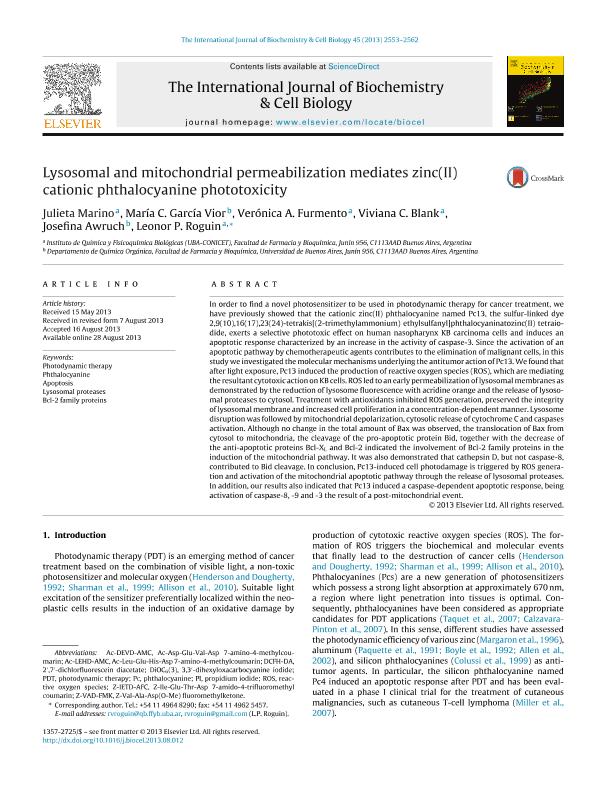Artículo
Lysosomal and mitochondrial permeabilization mediates zinc(II) cationic phthalocyanine phototoxicity
Marino, Veronica Julieta ; Garcia Vior, María Cecilia
; Garcia Vior, María Cecilia ; Furmento, Verónica Alejandra
; Furmento, Verónica Alejandra ; Blank, Viviana Claudia
; Blank, Viviana Claudia ; Awruch, Josefina
; Awruch, Josefina ; Roguin, Leonor Patricia
; Roguin, Leonor Patricia
 ; Garcia Vior, María Cecilia
; Garcia Vior, María Cecilia ; Furmento, Verónica Alejandra
; Furmento, Verónica Alejandra ; Blank, Viviana Claudia
; Blank, Viviana Claudia ; Awruch, Josefina
; Awruch, Josefina ; Roguin, Leonor Patricia
; Roguin, Leonor Patricia
Fecha de publicación:
11/2013
Editorial:
Elsevier
Revista:
International Journal Of Biochemistry And Cellular Biology
ISSN:
1357-2725
Idioma:
Inglés
Tipo de recurso:
Artículo publicado
Clasificación temática:
Resumen
In order to find a novel photosensitizer to be used in photodynamic therapy for cancer treatment, we have previously showed that the cationic zinc(II) phthalocyanine named Pc13, the sulfur-linked dye 2,9(10),16(17),23(24)-tetrakis[(2-trimethylammonium) ethylsulfanyl]phthalocyaninatozinc(II) tetraiodide, exerts a selective phototoxic effect on human nasopharynx KB carcinoma cells and induces an apoptotic response characterized by an increase in the activity of caspase-3. Since the activation of an apoptotic pathway by chemotherapeutic agents contributes to the elimination of malignant cells, in this study we investigated the molecular mechanisms underlying the antitumor action of Pc13. We found that after light exposure, Pc13 induced the production of reactive oxygen species (ROS), which are mediating the resultant cytotoxic action on KB cells. ROS led to an early permeabilization of lysosomal membranes as demonstrated by the reduction of lysosome fluorescence with acridine orange and the release of lysosomal proteases to cytosol. Treatment with antioxidants inhibited ROS generation, preserved the integrity of lysosomal membrane and increased cell proliferation in a concentration-dependent manner. Lysosome disruption was followed by mitochondrial depolarization, cytosolic release of cytochrome C and caspases activation. Although no change in the total amount of Bax was observed, the translocation of Bax from cytosol to mitochondria, the cleavage of the pro-apoptotic protein Bid, together with the decrease of the anti-apoptotic proteins Bcl-XL and Bcl-2 indicated the involvement of Bcl-2 family proteins in the induction of the mitochondrial pathway. It was also demonstrated that cathepsin D, but not caspase-8, contributed to Bid cleavage. In conclusion, Pc13-induced cell photodamage is triggered by ROS generation and activation of the mitochondrial apoptotic pathway through the release of lysosomal proteases. In addition, our results also indicated that Pc13 induced a caspase-dependent apoptotic response, being activation of caspase-8, -9 and -3 the result of a post-mitochondrial event.
Archivos asociados
Licencia
Identificadores
Colecciones
Articulos(OCA HOUSSAY)
Articulos de OFICINA DE COORDINACION ADMINISTRATIVA HOUSSAY
Articulos de OFICINA DE COORDINACION ADMINISTRATIVA HOUSSAY
Citación
Marino, Veronica Julieta; Garcia Vior, María Cecilia; Furmento, Verónica Alejandra; Blank, Viviana Claudia; Awruch, Josefina; et al.; Lysosomal and mitochondrial permeabilization mediates zinc(II) cationic phthalocyanine phototoxicity; Elsevier; International Journal Of Biochemistry And Cellular Biology; 45; 11; 11-2013; 2553-2562
Compartir
Altmétricas



